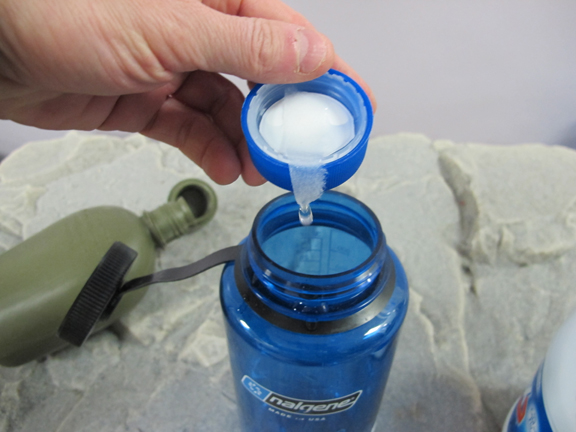I’ve been getting a lot of questions about this topic lately and I thought it would be a good idea to do a more lengthy post on the subject.
As everyone knows, many municipal water systems use chlorine to disinfect water. Often, the use of chlorine is combined with other purification systems such as filtration and ultra violet treatments. All you have to do is sniff your water tap water – it’s no secret. Why chlorine? Simple – it works.
It just so happens that Sodium Hypochlorite is the active ingredient in common household bleach. Sodium Hypochlorite is the source of chlorine in bleach. Most ‘off-the-shelf’ bleach products will contain in between 4 and 6% available chlorine. It is in this range that all of the below information and ratios are based. You will want to read the label and verify this first – otherwise you are just guessing.
It’s important that you only use regular bleach – nothing fancy with flowers, fresh mountains and little teddy bears on the label. No frills – standard – unscented bleach. The label should look like below:
When it comes to disinfecting water, it seems there is a different ratio and percentage for all kinds of different purifying agents and it can get really confusing. It can be hard to keep these ratios and solutions straight but it is very important that we do. All of the liters, quarts, drops, gallons, mL, cups and percentages are very easy to loose track of. I have a very simple memory phrase when it comes to disinfecting water with bleach. Once you read this phrase, you will never forget how to disinfect water with bleach again. The phrase is:
You must be 21 to drink.
How simple is that? It is a simple reminder that you need 2 drops of bleach per 1 liter or quart of water – hence 21. And, that just happens to be the legal drinking age in the US so it’s very easy to remember. Now, you will never forget it. If you don’t have a 1 liter or 1 quart container in which to measure an exact amount of water, it’s OK. Just remember that there are 4 quarts in a gallon and you can guesstimate the amount from there. Everyone knows about how much is in 1 gallon. Think about 1 gallon of milk and divide into fourths. You do need to wait a while before drinking, though. The wait time is 30 minutes. I remember this with: 2 + 1 = 3.
Have you ever tried to get a couple drops out of a gallon of liquid. It’s actually not the easiest thing in the world to do. Here is how I do it. You just need the cap to the bottle and a little piece of paper – toilet paper works great.
Then, place your ‘paper wick’ into a full cap with one end hanging over and it will begin to wick up the liquid and when turned at a slight angle will provide you with nice steady consistent drip that you can easily count.
A note about the water
It is important that your water be clear and void of debris for the above calculations to be effective. Ideally, you are already beginning with clear water. However, have you ever heard of an IDEAL survival situation? Me neither. Consequently, you may need to Pre-Filter your water BEFORE you disinfect it. You can prefilter your water using a huge variety of items – sock, t-shirt, bandanna, dried grass, feminine hygiene product and the list goes on an on. You may even want to prefilter a couple of times. Chlorine will not disinfect sediments. If your water is cloudy, double the chlorine dose and the wait time.
Don’t Forget the Threads
If you are using a bottle with a threaded/screw-on cap, don’t forget to unscrew the cap a bit and slosh some of the chlorine treated water into the threads. Otherwise, the water trapped in these threads could contaminate your water all over again.
Using bleach to disinfect water isn’t just a back-yard survival tactic. It is even recommended by the Environmental Protection Agency (EPA) as a viable form of disinfecting water in an emergency scenario. You can check out their writings on their web-site here if you wish: http://water.epa.gov/drink/emerprep/emergencydisinfection.cfm They also cover Iodine.
Conclusion
Chlorine bleach is a very common item in our society. It’s good to know how we can use it to disinfect water if we needed to one day. As I always say, it’s better to know it and never use it than to not know and need it. Hopefully, this has cleared up some questions that anyone has about disinfecting water with bleach. It certainly isn’t the only available chemical that we can use to disinfect water but it is a very common and viable option.
Thoughts anyone?
Remember, it’s not IF but WHEN,
Creek















4 Comments